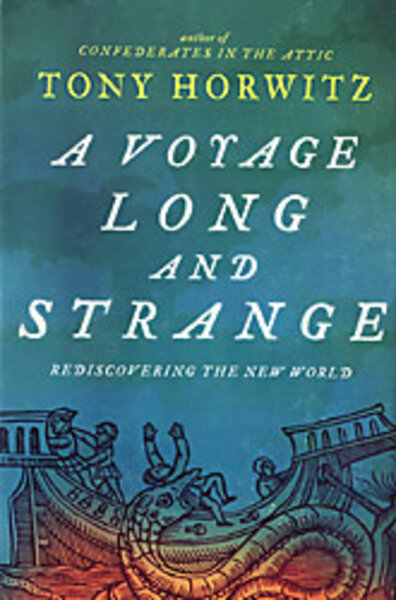'A Voyage Long and Strange' away from myth
Loading...
Pulitzer Prize-winning journalist Tony Horwitz travels a far distance in A Voyage Long and Strange only to finally hear the truth from the Rev. Peter Gomes of Harvard University's Memorial Church. "Myth is more important than history," Mr. Gomes tells him. "Myth trumps fact, always does, always has, always will."
Horwitz, author of the bestselling "Confederates in the Attic," skillfully combines history and travel in this entertaining, insightful account of his road trip into America's past. The trip was spurred by Horwitz's horrified discovery that, despite his history degree from a prestigious US university, he knew almost nothing about the first Europeans to arrive in America – in other words the "awful lot" of stuff that happened "between Columbus and the Pilgrims."
What Horwitz discovers as he travels takes much of the sheen off the events glorified in our grammar school history books.
Fittingly, he begins his odyssey at the "mythical" birthplace of America, Plymouth Rock. Moving backward in time, he then travels to Newfoundland, seeking traces of Viking Leif Eriksson and the Norse settlement he established there in AD 1000. Instead, he finds frigid temperatures and barren landscapes. (At the site of a disappointing Viking settlement, Horwitz asks a man in a parked car about Vikings: "No Vikings here, never were," the man says, "They'd a found a better place than this.")
Horwitz stays ever in motion. He visits Newfoundland's Micmac tribe (whose descendants probably chased out the Vikings), follows Christopher Columbus to the Dominican Republic, conquistadors Ponce de León into Florida, Francisco Coronado into America's Southwest, and Hernando de Soto across the American South.
Like travel writer Bill Bryson, Horwitz has a penchant for meeting colorful characters and getting himself into bizarre situations. In a moment reminiscent of "Confederates in the Attic" (Horwitz's book about Civil War reenactors), he travels with a group of Florida's conquistador reenactors and even dons their heavy Spanish armor, in which he "lurched and creaked like the Tin Man."
In St. Augustine, Fla., the oldest permanent European settlement in the country (founded in 1565), Horwitz bemoans the "Disneyfication" of the city's long history, with Spain's decidedly mixed legacy being sanitized and turned into what Horwitz views as tourist-friendly hucksterism. (Given the brutal behavior of many of the Spanish conquistadors, a disgruntled employee of the St. Augustine tourist industry tells Horwitz that, "Celebrating them is like idolizing Charles Manson.")
Horwitz also focuses on the failed English settlement on Roanoke Island, North Carolina, and the nearly-failed settlement at Jamestown, Virginia. He describes Capt. John Smith, a leader at Jamestown whose writings would encourage the Plymouth settlers, as a quintessential American for putting his commercial interests above the truth. (Horwitz notes that Smith's wondrous – if factually questionable – accounts of the Jamestown settlement were "published as propaganda for the Virginia Company." ) [Editor's note: The original version incorrectly located Roanoke Island.]
Horwitz finishes his journey back in Plymouth again – now feeling sadder but wiser. He ponders biologist Stephen Jay Gould's assertion that human beings "have a psychic need for an indigenous creation myth." In the case of the United States, he realizes, the truth is that "the country's European founding was slow and messy."
Fortunately for us, the voyage that brings Horwitz to this understanding is rich with reading pleasure.
• Chuck Leddy is a freelance writer and member of the National Book Critics Circle.






